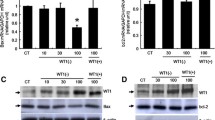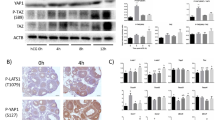Abstract
The par-4 gene, directs the expression of a protein in the rat ventral prostate after apoptotic stimuli but not growth stimulatory, growth arresting or necrotic signals. Since Par-4 expression appears to be ubiquitous we investigated the possibility of Par-4 having a role in the rat ovary granulosa cells apoptotic death. Par-4 mRNA was detected by RT-PCR with oligonucleotides designed to prime Par-4 leucine zipper in the ovaries of 12 day old rats and reached the higher levels in 24 days old rats. In situ hybridization analysis revealed that Par-4 expression is restricted to granulosa cells. PMSG priming of 24 day old rats for 2 days greatly reduced Par-4 expression in granulosa cells as determined by in situ hybridization, RT-PCR of mRNA and protein immunodetection with Western blot. Granulosa cells placed in serum-fee culture, exhibited increased levels of Par-4 mRNA and protein, in good correlation with the degree of apoptosis. The culture-induced increases in Par-4 are significantly prevented by FSH. Transient transfection of granulosa cells with Par-4 leucine zipper domain that functions as a dominant-negative regulator of Par-4 activity resulted in lower rates of apoptosis while overexpression of the full length Par-4 counteracted FSH effects on apoptosis. Par-4 association with PKCζ which is supposed to inhibit this kinase mediated antiapoptotic way is also prevented by FSH and, FSH antiapoptotic effects are counteracted by a PKCζ specific inhibitor. These findings indicate that FSH by suppressing Par-4 expression in the ovary activates PKCζ-dependent antiapoptotic pathway and suggest that Par-4 is part of the mechanism underlying granulosa cells apoptotic demise.






Similar content being viewed by others
References
Hughes FM, Gorospe WC (1991) Biochemical identification of apoptosis (programmed cell death) in granulosa cells: Evidence for a potential mechanism underlying follicular atresia. Endocrinology 129:2415–2422
Tilly JI, Kowalski KI, Johnson AL, Hsueh AJW (1991) Involvement of apoptosis in ovarian follicular atresia and postovulatory regression. Endocrinology 129:2799–2801
Chun S-Y, Eisenhauer KM, Minami S, Billig H, Perlas E, Hsueh AJW (1996) Hormonal regulation of apoptosis in early antral follicles: Follicle-stimulating hormone as a major survival factor. Endocrinology 137:1447–1456
Billig H, Furuta I, Hsueh AJW (1993) Estrogens inhibit and androgens enhance ovarian granulosa cells apoptosis. Endocrinology 133:2204–2212
Tilly JL, Billig H, Kowalski KI, Hsueh AJW (1992) Epidermal growth factor and basic fibroblast growth factor suppress the spontaneous onset of apoptosis in cultures rat ovarian granulosa cells and follicles by a tyrosine kinase-dependent mechanism. Mol Endo 6:1942–1950
Williams FT, Smith CA, McCarthy NJ, Grimes ES (1992) Apoptosis: final control point in cell biology. T Cell Biol 2:263–267
Osborne BA, Schwartz LM (1994) Essential genes that regulate apoptosis. T Cell Biol 4:394–399
Evans GS, Chandler JA (1987) Cell proliferation studies in rat prostate: I. The proliferative role of basal and secretory epithelial cells during normal growth. Prostate 10:163–178
Evans GS, Chandler JA (1987) Cell proliferation studies in the rat prostate: II. The effects of castration and androgen-induced regeneration upon basal and secretory cell proliferation. Prostate 11:339–351
Sandford NL, Searle JW, Kerr JF (1984) Successive waves of apoptosis in the rat prostate after repeated withdrawal of testosterone stimulation. Pathology 16:406–410
Kyprianou N, Isaacs JT (1988) Activation of programmed cell death in the rat ventral prostate after castration. Endocrinology 122:552–5622
English HF, Kyprianou N, Isaacs JT (1989) Relationship between DNA fragmentation and apoptosis in the programmed cell death in the rat prostate following castration. Prostate 15:233–250
Schwartz L, Kosz L, Kay B (1990) Gene activation is required for developmentally programmed cell death. Proc Natl Acad Sci USA 87:6594–6598
Stanisic T, Sadlowsky R, Lee C, Grayhack JT (1978) Partial inhibition of castration-induced ventral prostate regression with actinomycin D and cycloheximide. Invest Urol 16:19–22
Briehl MM, Miesfeld RL (1991) Isolation and characterization of transcripts induced by androgen withdrawal and apoptotic cell death in the rat ventral prostate. Mol Endocrinol 5:1381–1388
Sells SF, Wood DP, Joshi-Barve SS, Muthukumar S, Rangnekar VM (1994) Commonality of the gene programs induced by effectors of apoptosis in androgen-dependent and -independent prostate cells. Cell Growth Diff 5:457–466
Boghaert ER, Sells SF, Walid A-J et al (1997) Immunohistochemical analysis of the proapoptotic protein Par-4 in normal rat tissues. Cell Growth Differ 8:881–890
Guo Q, Fu W, Xie J et al (1998) Par-4 is a mediator of neuronal degeneration associated with the pathogenesis of Alzheimer disease. Nat Med 4:957–962
Duan W, Zhang Z, Gash DM, Mattson MP (1999) Participation of prostate apoptosis response-4 in degeneration of dopaminergic neurons in models of Parkinson's disease. Ann Neurol 46:587–597
Pedersen WA, Luo H, Kruman I, Kasarskis E, Mattson MP (2000) The prostate apoptosis response-4 protein participates in motor degeneration in amyotrophic lateral sclerosis. FASEB J 14:913–924
Kruman II, Nath A, Maragos WF et al (1999) Evidence that Par-4 participates in the pathogenesis of HIV encephalitis. A J Pathol 155:39–46
Nalca A, Qiu SG, El-Guendy N, Krishnan S, Rangnekar VM (1999) Oncogenic Ras sensitizes cells to apoptosis by Par-4. J Biol Chem 274:29976–29983
Barradas M, Monjas A, Díaz-Meco MT, Serrano M, Moscat J (1999) The downregulation of the pro-apoptotic protein Par-4 is critical for Ras-induced survival and tumor progression. EMBO J 18:6362–6369
Qiu SG, Krishnan S, El-Guendy N, Rangnekar VM (1999) Negative regulation of Par-4 by oncogenic Ras is essential for cellular transformation. Oncogene 18:7115–7123
Colombel MC, Buttyan R (1993) Hormonal control of apoptosis: the rat prostate gland as a model system. Methods Cell Biol 46:369–385
Lopez-Blanco F, Gonzalez-Reyes J, Fanjul LF, Ruiz de Galarreta CM, Quintana J (1998) Chemiluminiscence-based detection of minute amounts of apoptotic DNA. BioTechniques 24:354–358
Santana P, Peña LA, Haimovitz-Friedman A et al (1996) Acid sphingomyelinase-deficient human lymphoblasts and mice are defective in radiation-induced apoptosis. Cell 86:189–199
McGee EA, Hsueh AJW (2000) Initial and cyclic recruitment of ovarian follicles. Endo Rev 21:200–214
Sells SF, Han S-S, Muthukkumar S et al (1997) Expression and function of the leucine zipper protein Par-4 in apoptosis. Mol Cell Biol 17:3823–3832
Johnstone RW, See RH, Sells et al (1996) A novel repressor, Par-4, modulates transcription and growth suppression functions of the Wilms’ tumor suppressor WT1. Mol Cell Biol 16:645–6956
Mattson MP, Duan W, Chan SL, Camandola S (1999) Par-4: an emerging pivotal player in neuronal apoptosis and neurodegenerative disorders. J Mol Neurosci 13:17–30
Cook J, Krishnan S, Ananth S, et al (1999) Decreased expression of the proapoptotic protein Par-4 in renal carcinoma. Oncogene 18:205–208
Lucas T, Partscher B, Krishnan S et al (2001) Differential expression levels of Par-4 in melanoma. Melanoma Res 11:379–383
Gurumurthy S, Vasudevan KM, Rangnekar VM (2001) Regulation of apoptosis in prostate cancer. Cancer Metastasis Rev 20:223–243
Díaz-Meco MT, Municio MM, Frutos S, et al (1996) The product of par-4, a gene induced during apoptosis, interacts with the atypical isoforms of protein kinase C. Cell 86:777–786
Diaz-Meco MT, Berra E, Municio MM, et al (1993) A dominant negative protein kinase C zeta subspecies blocks NF-kappa B activation. Mol Cell Biol 13:4770–4775
Wooten MW (1999) Function for NF-κB in neuronal survival: regulation by atypical protein kinase c. J Neurosci Res 58:607–611
Camandola S, Mattson MP (2000) Pro-apoptotic action of Par-4 involves inhibition of NFκB and suppression of Bcl-2 expression. J Neurosci Res 61:134–139
Erl W, Hansson GK, de Martin R, Draude G, Weber KS, Weber C (1999) Nuclear factor-κB regulates induction of apoptosis protein-1 expression in vascular smooth muscle cells. Circ Res 84:668–677
Li J, Kim J-M, Liston P, Li M, et al (1998) Expression of Inhibitor of apoptosis proteins (IAPs) in granulosa cells during ovarian follicular development and atresia. Endocrinology 139:1321–1328
Xiao CW, Ash K, Tsang BK (2001) Nuclear factor-κB-mediated X-linked inhibitor of apoptosis protein expression prevents rat granulosa cells from tumor necrosis factor α-induced apoptosis. Endocrinology 142:557–563
El-Guendy N, Zhao Y, Gurumurthy S, Burikhanov R, Rangnekar VM (2003) Identificationof a unique core domain of par-4 sufficient fro selective apoptosis induction in cancer cells. Mol Cell Biol 23:5516–5521
Gurumurthy S, Goswami A, Vasudevan KM, Rangnekar VM (2005) Phosphorylation of Par-4 by protein kinase A is critical for apoptosis. Mol Cell Biol 25:1146–1161
Qiu G, Ahmed M, Sells SF, Mohiuddin M, Weinstein MH, Rangnekar VM (1999) Mutually exclusive expression patterns of Bcl-2 and Par-4 in human prostate tumors consistent with down-regulation of Bcl-2 by Par-4. Oncogene 18:623–631
Boehrer S, Chow KU, Beske F et al (2002) In Lymphatic cells Par-4 sensitizes to apoptosis by down-regulating Bcl-2 and promoting disruption of mitochondrial membrane potential and caspase activation. Cancer Res 62:1768–1775
Tilly JL, Tilly KI, Kenton ML, Johnson AL (1995) Expression of members of the bcl-2 gene family in the immature rat ovary: equine chorionic gonadotropin-mediated inhibition of granulosa cell apoptosis is associated with decreased bax and constitutive bcl-2 and bcl-xlong messenger ribonucleic acid levels. Endocrinology 136:232–241
Hsu SY, Lai RJ, Finegold M, Hsueh AJ (1996) Targeted overexpression of Bcl-2 in ovaries of transgenic mice leads to decreases apoptosis, enhanced folliculogenesis, and increased germ cell tumorogenesis. Endocrinology 137:4837–4843
Woodruff TK, Lyon RJ, Hansen SE, Rice GC, Mather JP (1990) Inhibin and activin locally regulate rat ovarian folliculogenesis. Endocrinology 127:3196–3205
Pelletier J, Buckler AJ, Rogers A, Haber DA, Housman D (1991) Expression of the Wilms’ tumor gene WT1 in the murine urogenital system. Gene Dev 5:1345–1356
Hsu SY, Kubo M, Chun S-Y, Haluska FG Housman DE, Hsueh AJW (1995) Wilms’ tumor protein WT1 as an ovarian transcription factor: decreases in expression during follicle development and repression of inhibin-α gene promoter. Mol Endo 9:1356–1366
Acknowledgments
The authors wish to thank Dr VM Rangnekar for full length Par-4 plasmid. Also are grateful to Drs Nora Butta and Susana Larrucea for helpful discussions and technical advise on immunoprecipitation studies.
Author information
Authors and Affiliations
Corresponding author
Additional information
This work was supported by the Direccion General de Enseñanza Superior e Investigación Científica Grants 98/0234 to LFF. VM was a fellow of the Spanish Ministry of Education and Science.
Rights and permissions
About this article
Cite this article
Gonzalez, I.H., Santana, P., Gonzalez-Robayna, I. et al. Regulation of the expression of prostate apoptosis response protein 4 (Par-4) in rat granulosa cells. Apoptosis 12, 769–779 (2007). https://doi.org/10.1007/s10495-006-0019-7
Published:
Issue Date:
DOI: https://doi.org/10.1007/s10495-006-0019-7




